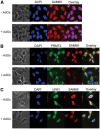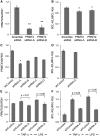PRMT2 interacts with splicing factors and regulates the alternative splicing of BCL-X
- PMID: 28057797
- PMCID: PMC5892402
- DOI: 10.1093/jb/mvw102
PRMT2 interacts with splicing factors and regulates the alternative splicing of BCL-X
Abstract
Protein arginine N-methyltransferase 2 (PRMT2) functions in JAK-STAT and Wnt/β-catenin signalling pathways, serves as a nuclear receptor-dependent transcriptional co-activator, and represses NF-κB and E2F1 transcription factor activities to promote apoptosis. We have previously demonstrated that PRMT2 interacts with PRMT1 and increases its activity. Here, we reveal associations using proteomics between the PRMT2 SH3 domain and splicing factors including Src-associated in mitosis 68 kDa protein (SAM68), a PRMT1 substrate and trans-acting factor that mediates BCL-X alternative splicing. We determined that PRMT2 interacts with SAM68 in cells and regulates its subcellular localization via the SH3 domain of PRMT2, prompting us to investigate the potential role of PRMT2 in BCL-X alternative splicing. We found that the expression of the full-length, wildtype form of PRMT2 promotes an increase in the BCL-X(L)/BCL-X(s) ratio in TNF-α or LPS stimulated cells. These results indicate that active PRMT2 may play a role during inflammation in alternative splicing regulation.
Keywords: BCL-X; PRMT2; SAM68; SH3 domain; alternative splicing.
© The Authors 2017. Published by Oxford University Press on behalf of the Japanese Biochemical Society. All rights reserved.
Figures





Similar articles
-
The RNA-binding protein Sam68 modulates the alternative splicing of Bcl-x.J Cell Biol. 2007 Mar 26;176(7):929-39. doi: 10.1083/jcb.200701005. Epub 2007 Mar 19. J Cell Biol. 2007. PMID: 17371836 Free PMC article.
-
A protein arginine N-methyltransferase 1 (PRMT1) and 2 heteromeric interaction increases PRMT1 enzymatic activity.Biochemistry. 2011 Sep 27;50(38):8226-40. doi: 10.1021/bi200644c. Epub 2011 Aug 29. Biochemistry. 2011. PMID: 21851090
-
hnRNP A1/A2 and Sam68 collaborate with SRSF10 to control the alternative splicing response to oxaliplatin-mediated DNA damage.Sci Rep. 2018 Feb 2;8(1):2206. doi: 10.1038/s41598-018-20360-x. Sci Rep. 2018. PMID: 29396485 Free PMC article.
-
Role of Sam68 in post-transcriptional gene regulation.Int J Mol Sci. 2013 Nov 28;14(12):23402-19. doi: 10.3390/ijms141223402. Int J Mol Sci. 2013. PMID: 24287914 Free PMC article. Review.
-
Structure, Activity and Function of the PRMT2 Protein Arginine Methyltransferase.Life (Basel). 2021 Nov 19;11(11):1263. doi: 10.3390/life11111263. Life (Basel). 2021. PMID: 34833139 Free PMC article. Review.
Cited by
-
Competing Endogenous RNA (ceRNA) Networks and Splicing Switches in Cervical Cancer: HPV Oncogenesis, Clinical Significance and Therapeutic Opportunities.Microorganisms. 2022 Sep 16;10(9):1852. doi: 10.3390/microorganisms10091852. Microorganisms. 2022. PMID: 36144454 Free PMC article. Review.
-
Elucidating the role of PRMTs in prostate cancer using open access databases and a patient cohort dataset.Histol Histopathol. 2023 Mar;38(3):287-302. doi: 10.14670/HH-18-513. Epub 2022 Sep 9. Histol Histopathol. 2023. PMID: 36082942
-
mRNA Metabolism in Cardiac Development and Disease: Life After Transcription.Physiol Rev. 2020 Apr 1;100(2):673-694. doi: 10.1152/physrev.00007.2019. Epub 2019 Nov 21. Physiol Rev. 2020. PMID: 31751167 Free PMC article. Review.
-
Protein arginine methyltransferase 2 controls inflammatory signaling in acute myeloid leukemia.Commun Biol. 2024 Jun 20;7(1):753. doi: 10.1038/s42003-024-06453-6. Commun Biol. 2024. PMID: 38902349 Free PMC article.
-
Intrafamily heterooligomerization as an emerging mechanism of methyltransferase regulation.Epigenetics Chromatin. 2024 Mar 1;17(1):5. doi: 10.1186/s13072-024-00530-0. Epigenetics Chromatin. 2024. PMID: 38429855 Free PMC article. Review.
References
-
- Lin W.J., Gary J.D., Yang M.C., Clarke S., Herschman H.R. (1996) The mammalian immediate-early TIS21 protein and the leukemia-associated BTG1 protein interact with a protein-arginine N-methyltransferase. J. Biol. Chem. 271, 15034–15044 - PubMed
-
- Lakowski T.M., Frankel A. (2009) Kinetic analysis of human protein arginine N-methyltransferase 2: formation of monomethyl- and asymmetric dimethyl-arginine residues on histone H4. Biochem. J. 421, 253–261 - PubMed
-
- Tang J., Gary J.D., Clarke S., Herschman H.R. (1998) PRMT 3, a type I protein arginine N-methyltransferase that differs from PRMT1 in its oligomerization, subcellular localization, substrate specificity, and regulation. J. Biol. Chem. 273, 16935–16945 - PubMed
-
- Chen D., Ma H., Hong H., Koh S.S., Huang S.M., Schurter B.T., Aswad D.W., Stallcup M.R. (1999) Regulation of transcription by a protein methyltransferase. Science 284, 2174–2177. - PubMed
-
- Schurter B.T., Koh S.S., Chen D., Bunick G.J., Harp J.M., Hanson B.L., Henschen-Edman A., Mackay D.R., Stallcup M.R., Aswad D.W. (2001) Methylation of histone H3 by coactivator-associated arginine methyltransferase 1. Biochemistry 40, 5747–5756. - PubMed
MeSH terms
Substances
Grants and funding
LinkOut - more resources
Full Text Sources
Other Literature Sources
Research Materials
Miscellaneous

